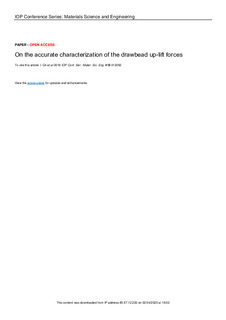Título
On the accurate characterization of the drawbead up-lift forcesFecha de publicación
2018Versión
Version publicadaTipo de documento
ArtículoArtículoIdioma
InglésAcceso
Acceso abiertoVersión de la editorial
http://dx.doi.org/10.1088/1757-899X/418/1/012092Publicado en
IOP Conference Series: Materials Science and Engineering Vol. 418. Nº 1. Institute of Physics Publishing. 21 September, 2018Editorial
IOP Publishing Ltd.Resumen
The competitiveness of the automotive sector has led to a high demand of accuracy and reduction in lead-time of the deep drawing tool making process. In that regard, the numerical simulation of the de ... [+]
The competitiveness of the automotive sector has led to a high demand of accuracy and reduction in lead-time of the deep drawing tool making process. In that regard, the numerical simulation of the deep drawing process has become a key method for the correct die design. Even though the accuracy of these simulations reached some high quality levels in terms of formability and defects, the material holding force remains an open issue among the die maker companies. This inaccuracy is related with the inability of shell elements to correctly reproduce the behavior of the material around the drawbeads. In order to overcome this problem, commercial stamping software used an analytical model to predict the drawbead holding forces. Nevertheless, most of these models are based on an experimental methodology developed in the 70's that do not exactly represent the industrial drawbead configuration. In order to be able to experimentally analyze the necessary up-lift force of each drawbead, in this work a new experimental procedure is presented. A wide range of automotive sector materials, ranging from mild steels up to high strength steels, have been tested and new values, compared with previous experiments, have been found. In that regard, the force distribution on the drawbead is also studied stressing the importance of the flat surfaces around the drawbead more than the drawbead punch itself. [-]
Sponsorship
Gobierno de EspañaID Proyecto
GE/Retos-Colaboración del Programa Estatal de Investigación, Desarrollo e Innovación Orientada a los Retos de la Sociedad, en el marco del Plan Estatal de Investigación Científica y Técnica y de Innovación 2013-2016. RTC-2015-3643-4/ES/Nueva generación de troqueles más estables y con vida útil prolongada para el conformado de aceros avanzados de alto límite elástico para automoción/HRDColecciones
- Artículos - Ingeniería [758]
El ítem tiene asociados los siguientes ficheros de licencia:






















